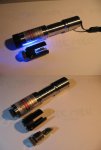- Joined
- Nov 26, 2008
- Messages
- 10
- Points
- 0
i know i know enough with all the dorcy jr questions!! and i did read other threads about this build, but this is my first build so i thought id make sure id get it right!! maybe i just wasnt clear about the other threads, but im planning on putting the blu-ray in a dorcy.. i ordered the blu-ray with the rkstr micro driver and i understand that i need to use the flexdrive, and the full body heat sink from hark horse, so does this mean i must remove the "guts" from the dorcy? i want to keep it simple since i dont have much knowledge in these territories! i know that the dorcy has a led driver, does this need to be removed? if i do remove it will i have to hook up the on-off button differently? i still havent ordered my flex-drive but i will as soon as i do some practice soldering lol. and my second question, is if i decided to do a red laser build also using the dorcy, what driver would i use? cuz i understand that the flex drive boosts power, so would this be a problem? since the red diodes take less power to operate? i was lookin to make an open can running at about 420ma. thanks in advanced!!! sorry for the noob questions guys but i appreciate all the help.. 





